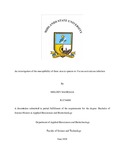Please use this identifier to cite or link to this item:
https://cris.library.msu.ac.zw//handle/11408/3740Full metadata record
| DC Field | Value | Language |
|---|---|---|
| dc.contributor.author | Mandaza, Melody | - |
| dc.date.accessioned | 2019-10-14T09:53:00Z | - |
| dc.date.available | 2019-10-14T09:53:00Z | - |
| dc.date.issued | 2019 | - |
| dc.identifier.uri | http://hdl.handle.net/11408/3740 | - |
| dc.description.abstract | Acacia species are indigenous trees which are of great importance in Zimbabwe. They can be used for various purposes for example making pulp and tannin, as cattle feed, as fuel (charcoal and wood) and for timber production which can be used for construction purposes. However, Acacia species are being affected by Viscum articulatum in Zimbabwe especially in Greystone Park, Mazowe district, Glen Lorne and some parts of Midlands province. At present, Acacia trees affected by the Viscum articulatum are pruned to remove all the infected parts. The removed parts are buried to control the parasite and in heavily infested cases they are cut down and burnt as a way of controlling the Viscum articulatum parasite from spreading. A study was carried out at Forestry Commission to investigate the susceptibility of three Acacia species (Acacia sieberiana, Acacia polyacantha and Acacia nilotica) to Viscum articulatum infection between mid-January 2018 and mid-February 2019. Samples of Viscum articulatum parasite were collected from Hakuna Matata Primary School and Gaydon road in Greystone park form Acacia hosts. Inoculation of parasite was done by watering with infected water and by means of air layering for a period of four months. Five seedlings of each of the three Acacia species were used. Susceptibility of the species to the infection was determined by the development of the mistletoe and growth retardation of the seedlings. It was observed that Acacia sieberiana and Acacia polyacantha showed greater retardation by the infection especially on the seedlings which were inoculated by air layering compared to watering. Acacia sieberiana which was inoculated by means of air layering developed mistletoe which grew up to a mean height of 19 µm and recorded highest proportion (100%) of seedlings showing signs of infection after a four months period. The controls, which were the untreated seedlings, were not affected. Findings from this study shows that Acacia nilotica is less susceptible to Viscum articulatum whilst Acacia sieberiana and Acacia polyacantha are susceptible, therefore growing Acacia nilotica which is less susceptible to the infection can be a method of choice as it is environmental friendly other than making use of chemicals. | en_US |
| dc.language.iso | en | en_US |
| dc.publisher | Midlands State University | en_US |
| dc.subject | Acacia species | en_US |
| dc.subject | Indigenous trees | en_US |
| dc.title | An investigation of the susceptibility of three Acacia species to Viscum articulatum infection | en_US |
| item.fulltext | With Fulltext | - |
| item.languageiso639-1 | en | - |
| item.grantfulltext | open | - |
| Appears in Collections: | Bachelor Of Science In Applied Biosciences And Biotechnology Honours Degree | |
Files in This Item:
| File | Description | Size | Format | |
|---|---|---|---|---|
| MELODY_MANDAZA_pdf.pdf | Full Text | 4.72 MB | Adobe PDF |  View/Open |
Page view(s)
120
checked on Apr 5, 2025
Download(s)
72
checked on Apr 5, 2025
Google ScholarTM
Check
Items in MSUIR are protected by copyright, with all rights reserved, unless otherwise indicated.



